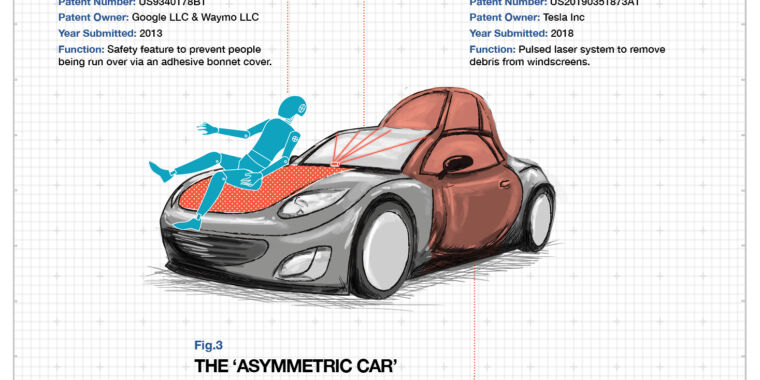
-
Vanarama
-
In Europe, they take pedestrian safety seriously, and EuroNCAP tests active hoods.
-
The Buick Regal is the only US-market vehicle I can think of that has been available with an active safety feature for the hood to prevent pedestrian injuries.Buick
-
-
Volvo (among others) has also played with the idea of a mobile office, in the 360c concept.Volvo
-
I saw this digital window display at Texas Instruments' booth at CES in 2019.Jonathan Gitlin
-
-
The rear of the current Toyota Prius looks the way it does because of airflow.Toyota
-
-
Ford has been interested in e-bikes for a while now.Ford Motor Company
-
-
The Smart Car was also meant to address the problem of parking. Theoretically you could fit three into the space needed by two normal cars, or park it sideways to the curb. But many parking spaces are already a predetermined length, and few jurisdictions allow you to park sideways to the curb.Tim Rue/Bloomberg via Getty Images
-
-
We already drink in cars, so of course someone thought up an in-car coffee machine.Gerry Goodstein/NBCU Photo Bank
-
-
An AeroMobil s.r.o. flying car sits on display during the second media preview day of the IAA Frankfurt Motor Show in Frankfurt, Germany, on Wednesday, Sept. 13, 2017. Geely bought Terrafugia, so who knows?Krisztian Bocsi/Bloomberg via Getty Images
-
At CES a few years ago, Rinspeed showed this concept that had its own drone.Rinspeed
-
Via Vanarama this morning, we have a curious list of patents from the auto industry. Some of them are a little wacky and unlikely to bring their inventors much fame or fortune— vertical parking falls into this category, as does the in-car urinal. But among the list are ideas that aren't that crazy. Like adaptive body panels that would extend a car's tail to reduce drag at cruising speeds.
Drag is the enemy of fuel efficiency, and every little bit helps when trying to cut a vehicle's drag coefficient—just changing the shape of an electric car's wheels can have a meaningful effect on how far its battery will take you. How the air flows away from the car at its rear is critically important to the amount of drag it experiences, and a longer tail is the most efficient shape.
That's easier to do when you're an airplane and not a car that has to fit into conventional-length parking spaces, which is where a Toyota patent for a telescoping tail comes in. I've definitely seen the idea tested by hypermilers in the past, and I don't know about you but I think this dark future of ours would be a little brighter if our cars morphed a little bit.
Tesla makes an appearance in the list via a 2019 patent for using lasers to keep a windshield clean instead of wipers. Advanced driver assistance systems like Tesla's lane keeping function depend on optical sensors to know where the lane markings on a road are, so you can understand how important it is that their vision not become occluded.
Another idea that may well make it to production made the list via a patent from Uber's Advanced Technology Group for a "light output system for a self-driving vehicle." Although a lot of attention is being paid to how an autonomous vehicle can interpret and understand the intentions of pedestrians or other road users, people are also approaching the problem from the other side: how should an autonomous vehicle communicate its intentions to human beings?
One idea, represented in Uber's patent, would be to project a pedestrian crossing on the ground in front of the stopped car to indicate it's safe. We've seen similar ideas at CES in the past few years, particularly from Texas Instruments, and Volvo's 360c concept also featured some clever ideas about cars communicating with humans, both visually and with sounds.Waymo makes the cut via a patent for an adhesive hood; if an autonomous vehicle struck a pedestrian, the adhesive would secure them to the hood of the vehicle instead of allowing them to fall underneath its wheels. That might sound far-fetched, but in Europe—where pedestrian safety is given more than lip service—active pedestrian safety features have been on the market for some time. To the best of my knowledge, only the now-deceased Buick Regal Tour X provided this feature in the US.
Other ideas have me less convinced. In-car fragrance diffusers have been on the market in a few vehicles for a while now, but they still seem like a pointless gimmick. One with a dark side at Toyota involves a patent that included a function to "release the tear gas component inside the vehicle in a case in which an illegitimate engine start has been detected by an immobilizer of the vehicle." I can see why it let that one expire…
Listing image by Vanarama
"some" - Google News
February 12, 2020 at 09:21PM
https://ift.tt/37hRoeJ
The auto industry’s unseen inventions—some are weirder than others - Ars Technica
"some" - Google News
https://ift.tt/37fuoxP
Shoes Man Tutorial
Pos News Update
Meme Update
Korean Entertainment News
Japan News Update
Bagikan Berita Ini














0 Response to "The auto industry’s unseen inventions—some are weirder than others - Ars Technica"
Post a Comment